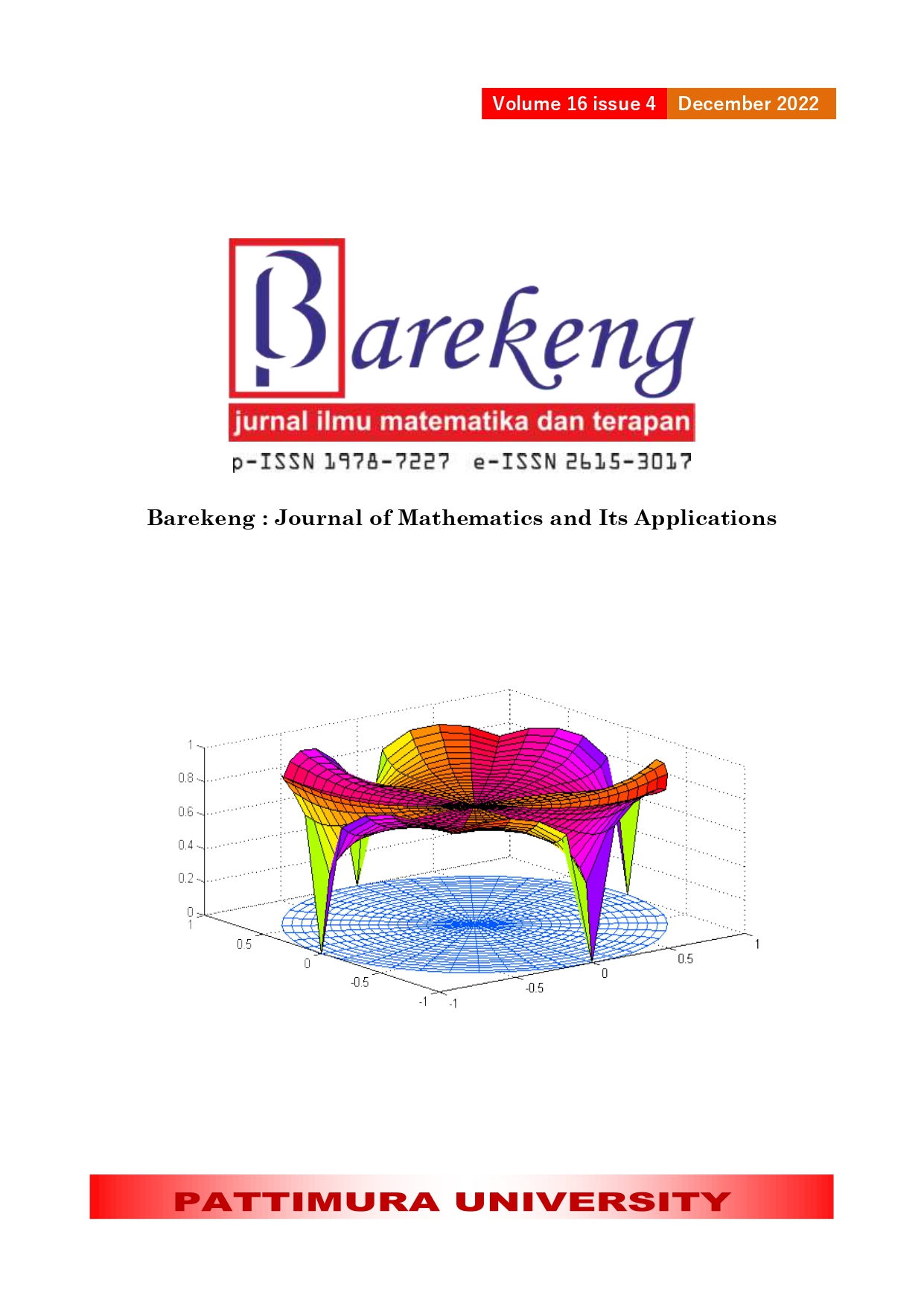FLUID FLOW MODELLING WITH FREE SURFACE
Abstract
Fluid is a substance that can flow in the form of a liquid or a gas. Based on the movement of the fluid is divided into static and dynamic fluids. This study discusses fluid dynamics, namely modelling fluid flow accompanied by a free surface and an obstacle in the fluid flow. Fluid modelling generally makes some basic assumptions into mathematical equations. The assumptions are incompressible, steady-state and irrotational. The steps to obtain a fluid flow model are using Newton’s second law, the law of conservation of mass, and the law of conservation of momentum to obtain the general Navier-Stokes equation, the designing the Euler free surface equation, the Bernoulli equation, then making a free surface representation and linearizing the wave equation so that it is obtained fluid flow model. The resulting mathematical model is a Laplace equation with boundary conditions in the fluid.
Downloads
References
S. L. Ross, Diferential Equations, New York: John Willey & Sons, 1984.
H. Pimentel, N. L. Bray, S. Puente, P. Melsted and L. Pachter, “Differential analysis of RNA-seq incorporating quantification uncertainty,” Nature Methods, vol. 14, no. 7, pp. 687-690, 2017.
G. D. Mauro, M. Schlotterer, S. Theil and M. Lavagna, “Nonlinear control for proximity operation based on differential algebra,” Journal of Guidance, Control, and Dynamics, vol. 38, no. 11, pp. 2173-2187, 2015.
M. Deserno, “Fluid lipid membranes: From differential geometry to cuvature stresses,” Chemistry and Physics of Lipids, vol. 185, no. 1, pp. 11-45, 2015.
S. B. Waluya, Persamaan Diferensial, Yogyakarta: Graha Ilmu, 2006.
M. Abdullah, Fisika Dasar 1, Bandung: Institut Teknologi Bandung, 2016.
J. H. Spurk and N. Aksel, Fluid Mechanics, Berlin: Springer, 2020.
J. Cornelis, M. Ihmsen, A. Peer and M. Teschner, “IISPH-FLIP for incompressible fluids,” Computer Graphics Forum, vol. 33, no. 2, pp. 255-262, 2014.
I. Liberal, M. Lobet, Y. Li and N. Engheta, “Near-zero-index media as electromagnetic ideal fluids,” Proceedings of the National Academy of Sciences, vol. 117, no. 39, pp. 24050-24054, 2020.
O. Glass, A. Munnier and F. Sueur, “Point vortex dynamics as zero-radius limit of the motion of a rigid body in an irrotational fluid,” Inventiones Mathematicae, vol. 214, no. 1, pp. 171-287, 2018.
C. A. Reynolds, H. Menke, M. Andrew, M. J. Blunt and S. Krevor, “Dynamic fluid connectivity during steady-state multiphase flow in a sandstone,” Proceedings of the National Academy of Sciences, vol. 114, no. 31, pp. 8187-8192, 2017.
M. Braack and P. B. Mucha, “Directional do-nothing condition for the Navier-Stokes equations,” Journal of Computational Mathematics, pp. 507-521, 2014.
D. C. Giancoli, Fisika: Prinsip dan Aplikasi Jilid 1, Jakarta: Erlangga, 2014.
R. Qin and C. Duan, “The principle and application of Bernoulli equation,” Journal of Physics: Conference Series, vol. 916, no. 1, p. 012038, 2017.
E. Noviani, Shape Optimisation for The Wave-Making Resistance of a Submerged Body. PhD [Dissertation]. Poitiers, France: Université de Poitiers., 2018. [Online]. Available: HAL Theses.
H. Bhatia, G. Norgard, V. Pascucci and P. T. Bremer, “The Helmholtz-Hodge decomposition--a survey,” IEEE Transactions on Visualization and Computer Graphics, vol. 19, no. 8, pp. 1386-1404, 2012.
Copyright (c) 2022 Anjeryan Sapta Pratama, Evi Noviani, Yudhi Yudhi

This work is licensed under a Creative Commons Attribution-ShareAlike 4.0 International License.
Authors who publish with this Journal agree to the following terms:
- Author retain copyright and grant the journal right of first publication with the work simultaneously licensed under a creative commons attribution license that allow others to share the work within an acknowledgement of the work’s authorship and initial publication of this journal.
- Authors are able to enter into separate, additional contractual arrangement for the non-exclusive distribution of the journal’s published version of the work (e.g. acknowledgement of its initial publication in this journal).
- Authors are permitted and encouraged to post their work online (e.g. in institutional repositories or on their websites) prior to and during the submission process, as it can lead to productive exchanges, as well as earlier and greater citation of published works.






1.gif)



